

![]()
![]()
![]()
![]()
![]()
![]()
![]()
![]()
 |
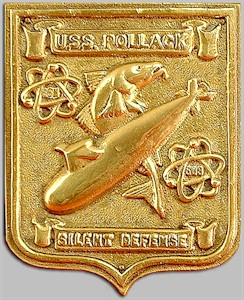 |
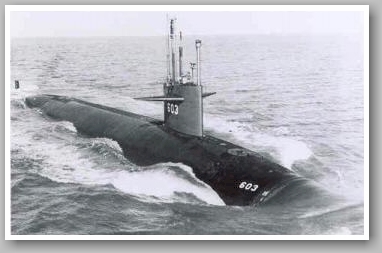
Commissioned 26 May 1964 ~ Decommissioned 1 March 1989

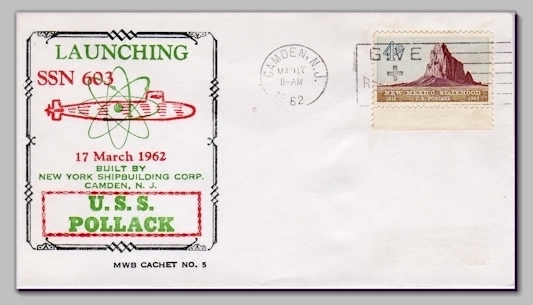
The
following technical data is from Jane's Fighting Ships:
Displacement
3,540 tons standard; 4,200 submerged
Length 278.5 ft.
Beam 31 ft. 8"
Draft 25.2 ft.
Torpedo tubes
4 - 21" (amidships)
ASW Weapons
SUBROC and ASW torpedoes
Main engines
2 steam turbines with single shaft; approx. 15,000 shp
Nuclear reactor 1
pressurized water cooled S5W (Westinghouse)
Speed 20 knts. surface; 30+ submerged
Test depth 1300 ft.
Complement
107 (12 officers, 95 enlisted men)
"Permit (ex-"Thresher")
Class" - These submarines were the first of a series of advanced attack
submarines intended to seek out and destroy enemy submarines, They have a
greater depth capability than previous nuclear powered submarines and are
the first to combine the UUM-44A SUBROC anti-submarine missile capability
with the advanced BQQ-5 sonar system and TB-16 Towed Sonar Array.
Additional tube launched armament: UGM-84A/C Harpoon, MK57 deep water
mines, and MK60 CAPTOR mines.
The lead ship of the class, the ill-fated USS THRESHER (SSN-593) was lost
off the coast of New England on 10 April 1963 while on post-overhaul
trials. She went down with 129 men on board.
Later submarines of this and subsequent classes were delayed because of
safety program (SUBSAFE) modifications, increased quality control of
submarine construction, and specific problems at the New York Shipbuilding
Corp and the Portsmouth Naval Shipyard.
The POLLACK, along with the PLUNGER. BARB, and DACE, were ordered as
guided missile submarines (SSGN) and were each to carry four Regulus II
missiles. They were reordered as "Thresher" class attack submarines after
the Regulus II program was cancelled on 18 Dec 1958 (for Regulus I program
see: USS HALIBUT).
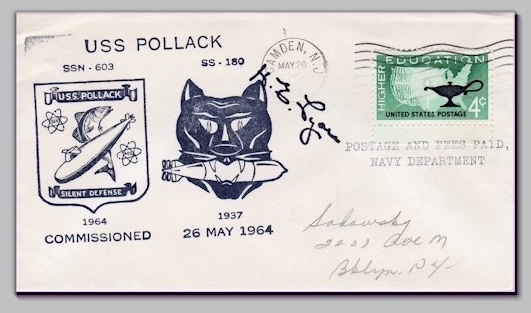
The following history was taken from the booklet "Twenty Five
Proud Years" which was provided at the Deactivation Ceremony on 16
November 1988 at the Mare Island Naval Complex, Vallejo, CA.
The USS POLLACK (SSN 603)
is the second ship to bear the name. The second USS POLLACK was originally
designated SS (N) 596 on 23 July 1959. SECNAV NOTICE 5030 changed POLLACK'S
designation to SS (N) 603 (BARB was originally SS (N) 603). POLLACK was constructed by New York
Shipbuilding Corporation, Camden, New Jersey. The keel was laid on 14 March
1960. She was launched on 17 March 1962 under the sponsorship of Senator John 0.
Pastore of Rhode Island and christened by his wife. POLLACK was the sixth
submarine of the THRESHER class (later designated PERMIT class), and was the
first built by New York Shipbuilding. POLLACK has a length of 279 feet; a
waterline midships of 25 feet; a standard displacement of 3750 tons surfaced and
4300 tons submerged; an operating depth in excess of 400 feet; and a maximum
speed in excess of 20 knots. The ship's crew is composed of 12 officers, 12
chiefs, and 92 enlisted men, for a compliment of 116 men. February 1964 saw POLLACK depart for
builder's trials and later for sonar acceptance trials. During 12-14 May the
ship underwent Combined Acceptance Trials under the scrutiny of the Board of
Inspection and Survey, Washington D.C. The Board found that the contractor had
met his contractual obligations and declared that the ship be turned over to the
Navy. On 25 May 1964 the commandant of the FOURTH Naval District, Rear Admiral
R. W. CAVENAUGH, accepted the ship for the Navy. The following day, in
ceremonies at Camden, New Jersey, Rear Admiral CAVENAGH directed that the ship
be placed in commission and she reported to Commander, U. S. Atlantic Fleet for
duty. Commander Harvey E. LYON, her prospective Commanding Officer for over two
years during construction, assumed command and directed the setting of the first
watch. Following commissioning, POLLACK
reported to Commander Submarine Squadron FOUR based in Charleston, S.C. Her
initial commitment was a shakedown cruise combined with acoustic trials in the
Caribbean area. The ship then began a series of operations in September 1964 to
evaluate the SSN 594-class submarine as an anti-submarine warfare (ASW)
platform. Ports of call during this period included New London, Fort Lauderdale,
and San Juan. The summer months of 1965 were spent
entirely at sea with POLLACK participating in various operations. Upon her
return to Charleston in September, Commander Robert P. MCDONALD relieved
Commander LYON as Commanding Officer. In October, POLLACK was again at sea
evaluating new anti-submarine warfare tactics, followed by participation in a
destroyer-versus-submarine evaluation. She participated as a member of the
opposing forces in PHIBASWEX 1-65 in December 1965. After a period of extended
operations, she returned to Charleston for the holidays. During the period January - March
1966, POLLACK underwent a Post-Shakedown Availability at Charleston Naval
Shipyard. Following brief sea trials, POLLACK commenced a series of operations
to evaluate the capability of the 594-class SSN in coordinated ASW operations. In June of 1966 POLLACK was awarded
the Navy Unit Commendation by the Secretary of the Navy, Paul H. NITZ. The
citation read:
"... for exceptionally meritorious service...through professional skills,
marked resourcefulness, and ingenuity of her officers and men... (whose)
inspiring performance of duty... was in accordance with the highest
traditions of the United States Navy."
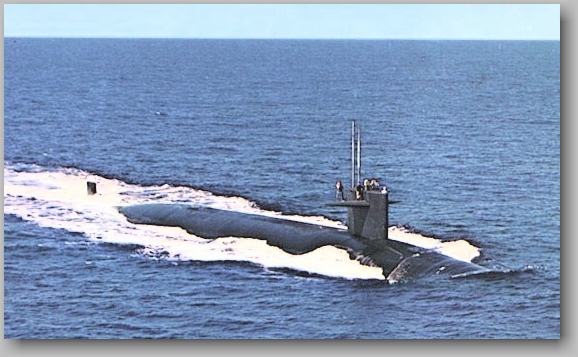
During October and November of 1966, POLLACK took part in a series of operations to further test 594 -class ASW weapons systems. Then in January 1967, POLLACK operated as a test vehicle for several CNO sponsored research and development projects.
In March, POLLACK successfully completed Weapons Systems Accuracy Trials at the Atlantic Fleet Weapons Range, St. Croix, Virgin Islands. Following these tests POLLACK launched two exercise SUBROC missiles. During most of the late spring and summer, POLLACK was again at sea conducting extensive operations.
POLLACK conducted operations out of Fort Lauderdale, Florida in September 1967, to conduct various weapons tests. On 11 December 1967, Commander D. D. BOYLE relieved Commander R. R. MCDONALD as Commanding Officer.
On that day the ship was awarded a second Navy Unit Commendation by Secretary of the Navy, Paul R. IGNATIUS,
"... for exceptional meritorious service . . . outstanding results. . . testifying to the exceptional professional skill, resourcefulness, ingenuity, and coordinated team spirit of POLLACK'S dedicated officers and men... Her inspiring performance of duty... was in keeping with the highest traditions of the United States Naval Service."
POLLACK was a leading contender for
Our Navy
magazine's "1967 Ship of the Year Award". In nominating her for this
distinction, Vice Admiral A. F. SCHADE, Commander Submarine Force, U. S.
Atlantic Fleet, stated: "Most of POLLACK'S operations, and
all significant ones, are classified. However, her accomplishments are well
known to the Chief of Naval Operations and to the Commander in Chief, U. S.
Atlantic
Fleet"
On 1 March 1968 POLLACK entered Norfolk Naval Shipyard. The overhaul was completed on 12 JUNE 1969. She then became a unit of New London - based Submarine Squadron TEN, the first all nuclear attack submarine squadron in the Navy.
During the period July through October 1969, POLLACK continued intensive training, torpedo exercises, sound trials, and Weapons Systems Accuracy Trials at the Atlantic Fleet Weapons Range, St. Croix, Virgin Islands. The first half of November was spent in an upkeep, followed by independent operations. POLLACK returned to New London in mid - January.
POLLACK received sudden orders in April to join the Sixth Fleet in the Mediterranean area. Emergency repairs were made to correct hull damage inflicted by a tug boat and POLLACK left for Rota, Spain on 1 May 1970. She returned to New London six months later.
February 1971 proved to be a rigorous month for the POLLACK as she prepared and departed for a deployment in the middle of the month. The schedule called for a short stop in Guantanamo Bay, Cuba followed by local operations out of Roosevelt Roads, Puerto Rico. "Rosie Roads" provided its usual recreational benefits during the time POLLACK was not steaming around the Caribbean. The ship departed the Puerto Rico area in mid - March and began her transit across the Atlantic.
Upon arrival in Rota, Spain, POLLACK was met with new operational orders and a new Captain. On 10 April 1971, Commander Scott A. CHESTER relieved Commander D. D. BOYLE as Commanding Officer. With her new skipper embarked, she began a series of operations in the Atlantic. Following these exercises and two short refits in Rota, POLLACK headed back to New London in early May.
A normally hectic upkeep began in June as POLLACK prepared for the Operational Reactor Safeguard Exam (ORSE) scheduled in July. The ship passed the ORSE and shifted training emphasis in preparation for the Navy Technical Proficiency Inspection (NTPI) scheduled in August.
There was no rest, however, as she departed New London for the Tongue of the Ocean in the Bahamas for her first SUBROC missile shot in over four years. After many practice approaches and battle stations drills, the shot was fired and the statistics and photographs again demonstrated the capabilities of the nuclear attack submarine.
Upon returning to New London, POLLACK found the NTPI inspectors waiting on the pier. Preparations began immediately after the inspection for a Mediterranean deployment scheduled for September.
17 September 1971 found POLLACK once again departing New London for a three - month deployment. The first two weeks were spent in the Caribbean participating in RIMEX 1 - 72, a fleet exercise. POLLACK then proceeded across the Atlantic to tie up alongside the USS HOLLAND in Rota, Spain on 10 October.
After two days of upkeep, POLLACK commenced operations in the Mediterranean. The MED deployment included two stops in Augusta Bay, Sicily and two short stops in Naples, Italy. While in the Naples area, POLLACK embarked Rear Admiral C. D. GROJEAN, Commander Submarine Flotilla EIGHT for four days.
Despite a short extension in the Mediterranean, POLLACK returned to Rota, Spain, took on stores and transited the Atlantic in time to spend Christmas at home, arriving in New London on 21 December 1971.
Following a two-week post-deployment R & R period during the Christmas holidays, POLLACK underwent a 30-day availability, spending part of the time alongside USS FULTON and the rest in the floating dry-dock at Submarine Base, New London. During the dry-dock availability, POLLACK was outfitted with the special equipment and bow modifications for project SNIPE, which started in February.
The second week of February 1972 saw POLLACK once again steaming down the Thames River, this time headed for Fort Lauderdale, Florida to conduct two weeks of project SNIPE operations and CAPTOR mine exercise.
The next month and a half was spent almost exclusively in a pre-overhaul upkeep, with the exception of one weekly operation which was cut short by a lube oil pump failure. Detailed preparations were made for off-loading the ship, beginning shipyard work, and moving dependents to Charleston, POLLACK'S new homeport during the overhaul.
On 24 April 1972, POLLACK departed New London once again, this time destined not to return for eighteen months.
January 1973 saw USS POLLACK continuing to make progress in the overhaul at Charleston Naval Shipyard. In September, POLLACK completed refueling her reactor.
In 1973, POLLACK had a 78% overall reenlistment rate, one of the highest in the Atlantic fleet.
In late December 1974, POLLACK commenced sea trials, thus marking the completion of the long overhaul period. Orders were received directing POLLACK to proceed to a new homeport in San Diego, California following overhaul to become a Unit of Submarine Squadron THREE.
POLLACK began 1975 by completing overhaul, a post-overhaul shakedown cruise, and local operations; and then transiting through the Panama Canal to San Diego. Arriving in San Diego on April 3, 1975 POLLACK was greeted by the Commander, U.S. Pacific Fleet Submarine Force and Commander, Submarine Squadron THREE. POLLACK spent six weeks in Pearl Harbor during August and September, participating in local operations and then returning to San Diego in October where Commander John W. ASHER III relieved Commander S. A CHESTER as Commanding Officer on 28 October 1975.
POLLACK commenced 1976 by participating in Exercise VALIANT HERITAGE, local operations, and a pre-overseas movement upkeep prior to an extended overseas deployment. During the WESTPAC trip she visited Yokosuka, Guam, Pusan, Chin Hae, Subic Bay, and Hong Kong. POLLACK participated in various submarine operations of great importance to national security. POLLACK returned to San Diego on 11 November.
POLLACK began 1977 conducting local
operations, followed by a refit alongside
USS SPERRY (AS 12) in San Diego. In March she steamed to the Pacific Northwest
to participate in Weapons Systems Accuracy Tests. While in this area, POLLACK
visited Bremerton, Washington and Nanoose, British Columbia. In May POLLACK
returned to San Diego for an upkeep and a dry-dock availability in the SAN
ONOFRE (ARD-30).
In July, POLLACK performed local operations, which included a visit to Santa Catalina Island. She completed the year with local operations and prepared for a WESTPAC deployment. POLLACK received the Battle Efficiency "E" for fiscal year 1977.
POLLACK began 1978 by departing on 16 January for a six-month deployment. Traveling via Pearl Harbor to the Western Pacific, POLLACK participated in READEX 1-78 prior to arriving in Subic Bay. POLLACK also visited Hong Kong and had an upkeep in Guam during her deployment. She participated in SEA SIAM Exercises with Thai Forces. On 24 April, Commander Michael M. RAGGETT relieved Commander J. W. ASHER as Commanding Officer. She returned home to San Diego in July after a visit to Pearl Harbor. POLLACK then completed an upkeep and participated in local operations in September and October. A dependents' cruise was held on 3 November, followed by an upkeep period. In December, POLLACK participated in VARSITY LANCE (FLEETEX 1-79).
POLLACK began 1979 by participating in local operations, then charged homeports to Mare Island Naval Shipyard, in Vallejo, CA. to begin an overhaul period.
POLLACK spent the entire years of 1980 and 1981 at Mare Island Naval Shipyard during which she received major SUBSAFE modifications, a new sonar system, and a new fire control system.
POLLACK spent the first half of 1982 concluding the overhaul at Mare Island Naval Shipyard. The overhaul was competed 19 August and POLLACK transited to her new homeport at San Diego, California. While in San Diego, POLLACK embarked on a series of training exercises and recertification inspections designed to polish operational, weapons, and engineering proficiency.
POLLACK completed post-overhaul refresher training in early 1982, including six weeks of acoustic trials and weapons testing in the Puget Sound area. In mid-February, the ship returned to homeport for pre-deployment maintenance and work-ups. On 13 March Commander Richard J. FIELD relieved Captain M. M. RAGGETT as Commanding Officer. The ship deployed to the Western Pacific from 28 June to 24 December. During this time, POLLACK conducted three special operations, participated in major fleet exercises, and visited the ports of Yokosuka, Chinhae, Guam, and Subic Bay.
POLLACK operated out of the local San Diego area throughout 1983. In February the ship completed an ORSE and received an overall grade of excellent. A Defense Nuclear Security Inspection (DNSI) in March also resulted in outstanding grades. From 21 March to 9 May POLLACK participated in FLEETEX 83-1. The exercise, involving six submarines and three carrier battle groups, took POLLACK from San Diego to Pearl Harbor, then to Yokosuka, and back to San Diego. POLLACK completed the first Selected Restricted Availability (SRA) conducted in San Diego during July and August. For the remainder of 1983 the ship participated in local operations.
POLLACK operated out of the local San Diego area throughout 1984 and deployed twice to the Western Pacific. From February through April the ship conducted special operations. During the trip, two port calls were made in Yokosuka, Japan. Following this deployment, the ship conducted local operations in the San Diego area. An ORSE was completed in May with an overall grade of excellent. Near the end of October, POLLACK again deployed to the Western Pacific, making only one stop in Yokosuka. Operations in the Western Pacific continued in 1985. POLLACK was awarded the Navy Unit Commendation for operations conducted during this period.

From January through April 1985 the ship continued the deployment, conducted an upkeep in Subic Bay, R.P., and made port calls in Hong Kong and Yokosuka, Japan. The ship returned to San Diego in late April and conducted local operations in the Southern California area. In July, Commander R. J. FIELD was relieved by Commander Prentice L HOUSE. A two-month SRA was conducted in August and September which included a drydocking. A port call to Bangor, Washington was made in November. Local operations were conducted during the remainder of 1985.
From January to June 1986 the ship conducted local operations in the Southern California area. From June to December POLLACK deployed to the Western Pacific to conduct special operations. During the deployment, the ship conducted an upkeep in Subic Bay, and made port calls to Sasebo and Yokosuka, and Chinhae, Korea. POLLACK returned to San Diego in December 1986.
POLLACK operated in the local San Diego area until August of 1987 and then deployed to the Northern Pacific from August to October to conduct special operations. After returning from the deployment, the ship prepared for inactivation and a change of homeport to Mare Island Naval Shipyard, Vallejo, California. USS POLLACK arrived in Mare Island on 21 November 1988. The ship joined Submarine Group Five in January 1988 and the shipyard availability for inactivation commenced the same month.
The Decommissioning booklet
had this quote:
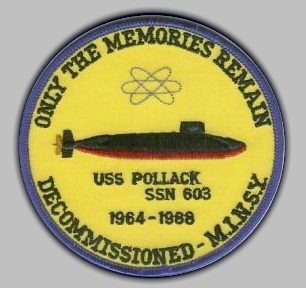
"The deactivation ceremony near the end of a ship's life is a commemoration to the success of the ship and the men who sailed her."
POLLACK was decommissioned and stricken from the Naval Vessel Register in ceremonies at the Naval Shipyard in Mare Island, California on 1 March 1989.
The former POLLACK went through the Navy’s Nuclear Powered Ship and
Submarine Recycling Program at Bremerton, Washington from 9 February 1993
to 17 February 1995 and was dismantled.
Article by
![]()
If you have any questions or comments, email me: gary@brewerygems.com
or
text me: 360-728-0062
All contents including images are copyright by AboutSubs.com
and can not be used without permission from AboutSubs.
Copyright © 1999 ~ All Rights Reserved.
![]() HOME |
EDISON |
SUNFISH |
HALIBUT |
HOLY LOCH |
DOLPHINS |
SALES ROOM |
LINKS |
SITE MAP
HOME |
EDISON |
SUNFISH |
HALIBUT |
HOLY LOCH |
DOLPHINS |
SALES ROOM |
LINKS |
SITE MAP